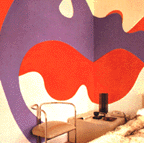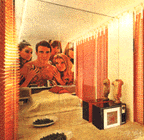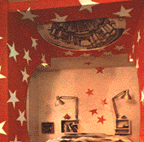

 supergraphics is the name for big arrows or numbers or words painted
on the walls of an interior. like wall-carpeting and beanbag chairs, it is
one aspect of "pop" interior design that survived through the 1970s by
hiding in american basement rec rooms. hardly anyone pulls this trick
nowadays, since it instantly "dates" a room to paint stripes across the
wall that run up to the ceiling. but i think we should consider reviving this
lost art: it's cheap, fairly easy, and boldly effective. if i wasn't always renting
from strict landlords, i would certainly consider it for my own living space.
supergraphics is the name for big arrows or numbers or words painted
on the walls of an interior. like wall-carpeting and beanbag chairs, it is
one aspect of "pop" interior design that survived through the 1970s by
hiding in american basement rec rooms. hardly anyone pulls this trick
nowadays, since it instantly "dates" a room to paint stripes across the
wall that run up to the ceiling. but i think we should consider reviving this
lost art: it's cheap, fairly easy, and boldly effective. if i wasn't always renting
from strict landlords, i would certainly consider it for my own living space.
 supergraphics was born about the same time that things like pop art, graphic
design, and popular culture were borrowing from each other - in the mid-60s. during that time, charles moore, who was teaching at yale's architecture
school, used it in his house, helping to legitimize and popularize it.
supergraphics was born about the same time that things like pop art, graphic
design, and popular culture were borrowing from each other - in the mid-60s. during that time, charles moore, who was teaching at yale's architecture
school, used it in his house, helping to legitimize and popularize it.
 according to norma skurka and oberto gili in their book underground interiors,supergraphics are our way to "reassert [our] superiority over the bullying of
urban developments and city-center slabs... by plastering them with numbers and gouging them with swaths of color -- spirals, circles, murals, numbers, stars,stripes, and whatever else [our] boundless imagination can dream up to express frustration and mischief." it's a reaction to the insides of buildings as well, and modern box-like rooms: "in modern buildings there is none of the inherent charm of earlier times given by wide, well-spaced windows, high ceilings, gracious staircases and doorways, rich moldings, and ceiling decoration. the cost of decorating these boxes to give them some of the atmosphere that they lack can be outrageous. but paint is cheap and colorful. it allows great scope for creative expression -- at the right price. if one doesn't like the results, they can be buried under more coats of solid white. easy, instant, inexpensive architecture -- and therein lies its appeal."
according to norma skurka and oberto gili in their book underground interiors,supergraphics are our way to "reassert [our] superiority over the bullying of
urban developments and city-center slabs... by plastering them with numbers and gouging them with swaths of color -- spirals, circles, murals, numbers, stars,stripes, and whatever else [our] boundless imagination can dream up to express frustration and mischief." it's a reaction to the insides of buildings as well, and modern box-like rooms: "in modern buildings there is none of the inherent charm of earlier times given by wide, well-spaced windows, high ceilings, gracious staircases and doorways, rich moldings, and ceiling decoration. the cost of decorating these boxes to give them some of the atmosphere that they lack can be outrageous. but paint is cheap and colorful. it allows great scope for creative expression -- at the right price. if one doesn't like the results, they can be buried under more coats of solid white. easy, instant, inexpensive architecture -- and therein lies its appeal."
 besides painting bold graphics on walls, ceilings, and sometimes furniture, supergraphics can be manifested in neon or billboards. you can get neon made to a custom design (which is expensive when you factor in the generator-thingy you need to power it) or use found/bought signs (watch out for the "miller lite" trap, though). as for billboards, i suppose you have to know someone in the business to get one before it's pasted up somewhere. these advanced techniques are stunning, but i would start with paint-supergraphics. inspired? you can find instructions in many 60s and 70s interior design books and magazines. and click on these pictures for bigger versions with credits.
besides painting bold graphics on walls, ceilings, and sometimes furniture, supergraphics can be manifested in neon or billboards. you can get neon made to a custom design (which is expensive when you factor in the generator-thingy you need to power it) or use found/bought signs (watch out for the "miller lite" trap, though). as for billboards, i suppose you have to know someone in the business to get one before it's pasted up somewhere. these advanced techniques are stunning, but i would start with paint-supergraphics. inspired? you can find instructions in many 60s and 70s interior design books and magazines. and click on these pictures for bigger versions with credits.